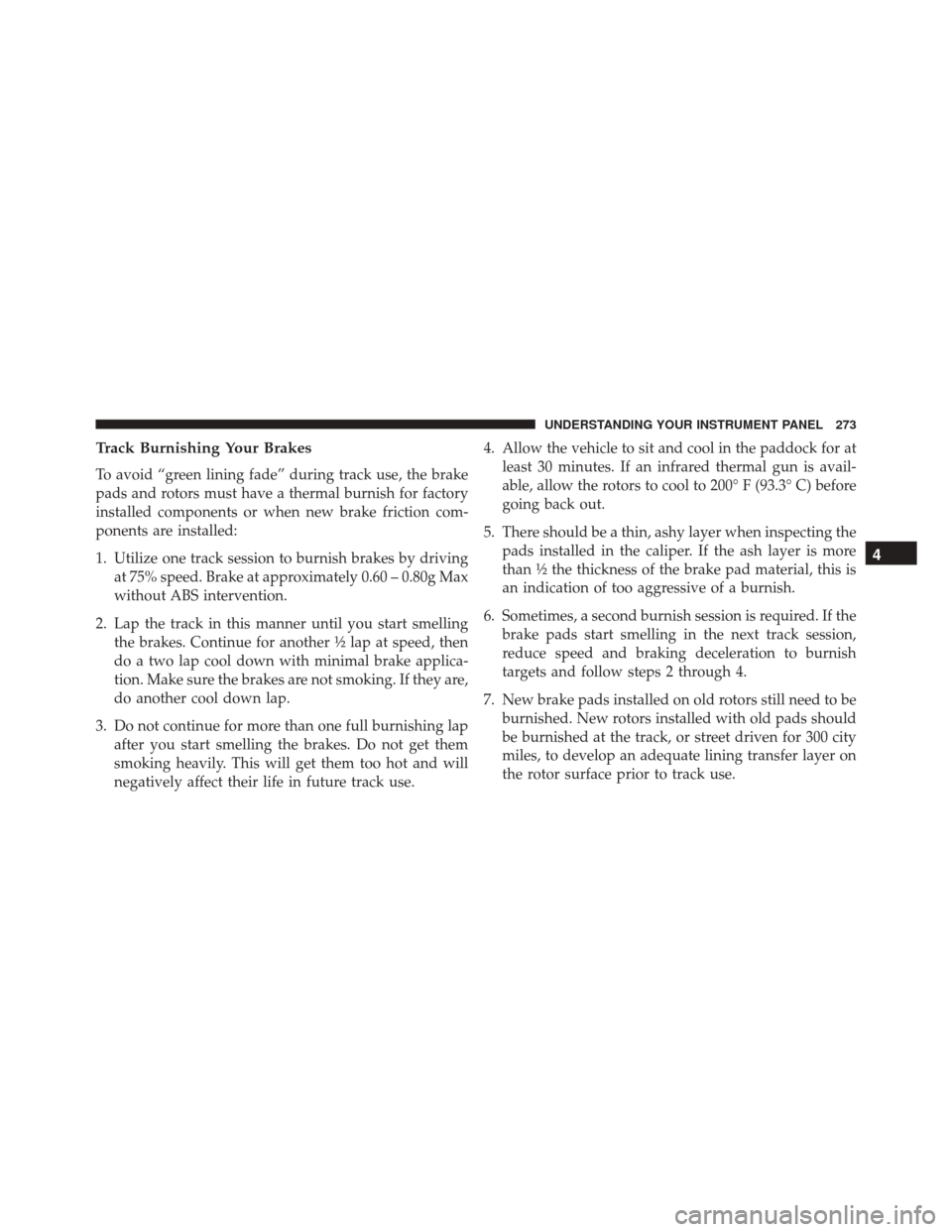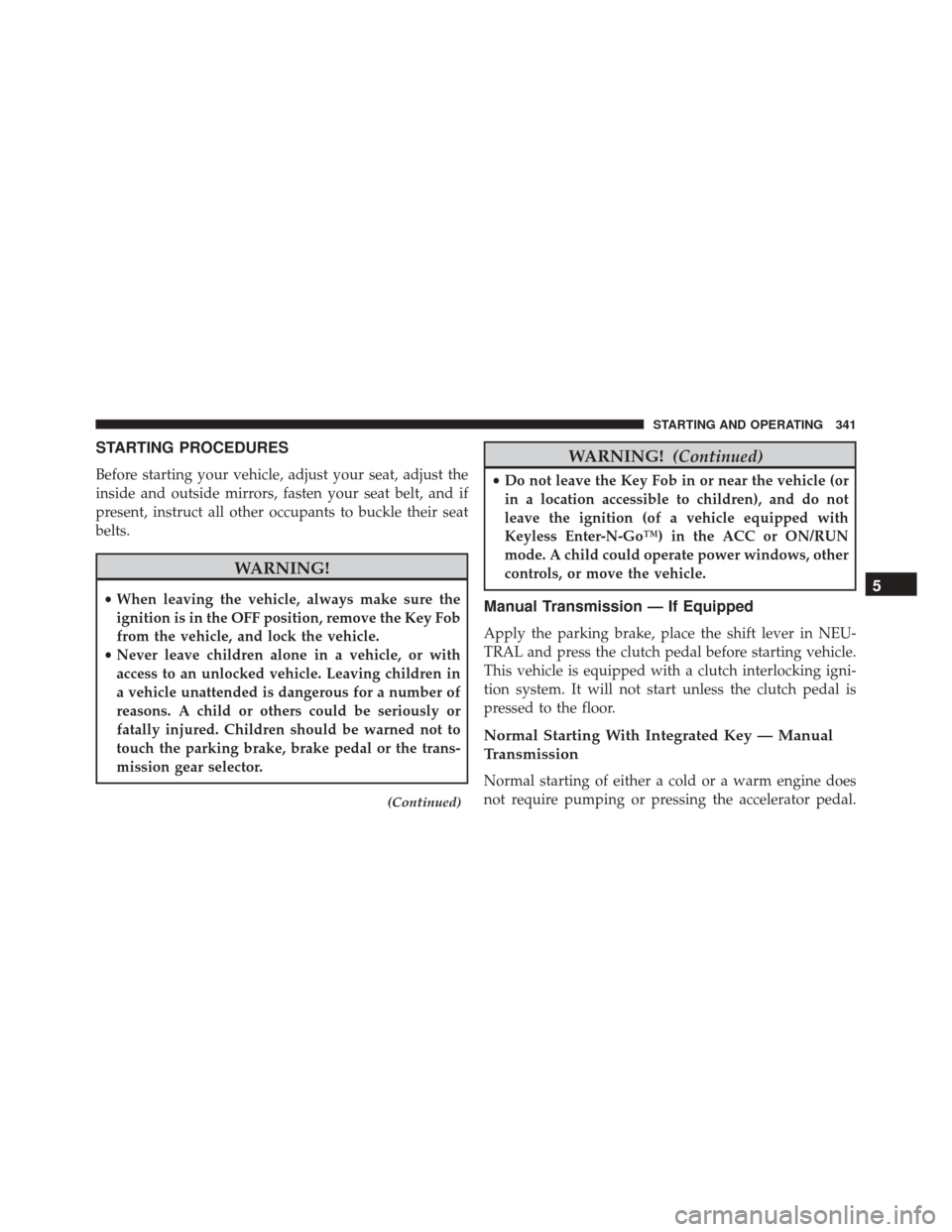Page 275 of 575

Track Burnishing Your Brakes
To avoid “green lining fade” during track use, the brake
pads and rotors must have a thermal burnish for factory
installed components or when new brake friction com-
ponents are installed:
1. Utilize one track session to burnish brakes by drivingat 75% speed. Brake at approximately 0.60 – 0.80g Max
without ABS intervention.
2. Lap the track in this manner until you start smelling the brakes. Continue for another ½ lap at speed, then
do a two lap cool down with minimal brake applica-
tion. Make sure the brakes are not smoking. If they are,
do another cool down lap.
3. Do not continue for more than one full burnishing lap after you start smelling the brakes. Do not get them
smoking heavily. This will get them too hot and will
negatively affect their life in future track use. 4. Allow the vehicle to sit and cool in the paddock for at
least 30 minutes. If an infrared thermal gun is avail-
able, allow the rotors to cool to 200° F (93.3° C) before
going back out.
5. There should be a thin, ashy layer when inspecting the pads installed in the caliper. If the ash layer is more
than ½ the thickness of the brake pad material, this is
an indication of too aggressive of a burnish.
6. Sometimes, a second burnish session is required. If the brake pads start smelling in the next track session,
reduce speed and braking deceleration to burnish
targets and follow steps 2 through 4.
7. New brake pads installed on old rotors still need to be burnished. New rotors installed with old pads should
be burnished at the track, or street driven for 300 city
miles, to develop an adequate lining transfer layer on
the rotor surface prior to track use.
4
UNDERSTANDING YOUR INSTRUMENT PANEL 273
Page 280 of 575

•Press the “Uconnect” button to save the runs to the
Owner web page.
• Press the “Cancel” button to view the last timer
“Ticket.”
The “Tickets” contain the timers listed below:
• Reaction Time
Measures the driver’s reaction time for launching the
vehicle against a simulated drag strip timing light (be-
havior modeled after 500 Sportsman Tree) displayed in
the Driver Information Display (DID).
NOTE: The Reaction Time, MPH, ⅛, and ¼ Mile timers
will be “ready” when the vehicle is at 0 MPH (0 km/h).
• 0-60 MPH (0-100 km/h)
Displays the time it takes for the vehicle to go from 0 to
60 mph (0 to 100 km/h). •
0-100 MPH (0-160 km/h)
Displays the time it takes for the vehicle to go from 0 to
100 mph (0 to 160 km/h).
• ⅛ Mile (200 meter)
Displays the time it takes for the vehicle to go an ⅛Mile
(200 meters).
• ¼ mile (400 meter)
Displays the time it takes for the vehicle to go an ¼ mile
(400 meters).
• Brake Distance
Displays the distance it takes the vehicle to make a full
stop. Contains current and last data for distance and start
– from speed.
NOTE: The distance measurement will be aborted if the
brake pedal is released before the vehicle comes to a
complete stop.
278 UNDERSTANDING YOUR INSTRUMENT PANEL
Page 281 of 575
•Brake Speed
Displays the speed the vehicle is traveling when the
brake pedal is depressed.
NOTE: Brake Distance and Speed timers will only dis-
play �ready� when vehicle is traveling at greater than 30
MPH (48 km/h).Gauges 1
SRT Performance Pages — Gauges 1 (6.2L Manual
Transmission)
4
UNDERSTANDING YOUR INSTRUMENT PANEL 279
Page 339 of 575
STARTING AND OPERATING
CONTENTS
�STARTING PROCEDURES ................341
▫ Manual Transmission — If Equipped ........341
▫ Automatic Transmission — If Equipped .....342
▫ Keyless Enter-N-Go™ ..................343
▫ Normal Starting ...................... .343
▫ Extreme Cold Weather
(Below –20°F Or �29°C) ................346
▫ If Engine Fails To Start .................346
▫ After Starting ....................... .348
� ENGINE BLOCK HEATER — IF EQUIPPED . . .348 �
MANUAL TRANSMISSION — IF EQUIPPED . .348
▫ Six-Speed Manual Transmission ...........348
▫ Shifting ............................ .350
▫ Recommended Shift Speeds ..............351
▫ 1–4 Skip Shift ....................... .352
▫ Downshifting ....................... .352
� AUTOMATIC TRANSMISSION ............353
▫ Key Ignition Park Interlock ...............354
▫ Brake/Transmission Shift Interlock System . . .354
5
Page 340 of 575

▫Eight-Speed Automatic Transmission — If
Equipped .......................... .355
� AUTOSTICK ......................... .362
▫ Steering Wheel Mounted Paddle Shifters Or
Console Mounted Shifter ................362
� DRIVE MODES ....................... .365
▫ Launch Mode — If Equipped .............370
▫ Guidelines For Track Use ................374
� DRIVING ON SLIPPERY SURFACES .........377
▫ Acceleration ........................ .377
▫ Traction ........................... .377
� DRIVING THROUGH WATER .............378
▫ Flowing/Rising Water ..................378
� POWER STEERING — 6.4L ENGINE .........380�
POWER STEERING — 6.2L SUPERCHARGED
ENGINE ............................ .381
�
FUEL SAVER TECHNOLOGY — IF EQUIPPED. . .382
� PARKING BRAKE ..................... .382
▫ Manual Transmission — If Equipped ........383
▫ Automatic Transmission — If Equipped ......383
� BRAKE SYSTEM ...................... .385
� ELECTRONIC BRAKE CONTROL SYSTEM . . . .386
▫ Anti-Lock Brake System (ABS) ............386
▫ Traction Control System (TCS) ............389
▫ Brake Assist System (BAS) ...............389
▫ Hill Start Assist (HSA) .................390
▫ Electronic Stability Control (ESC) ..........391
338 STARTING AND OPERATING
Page 343 of 575

STARTING PROCEDURES
Before starting your vehicle, adjust your seat, adjust the
inside and outside mirrors, fasten your seat belt, and if
present, instruct all other occupants to buckle their seat
belts.
WARNING!
•When leaving the vehicle, always make sure the
ignition is in the OFF position, remove the Key Fob
from the vehicle, and lock the vehicle.
• Never leave children alone in a vehicle, or with
access to an unlocked vehicle. Leaving children in
a vehicle unattended is dangerous for a number of
reasons. A child or others could be seriously or
fatally injured. Children should be warned not to
touch the parking brake, brake pedal or the trans-
mission gear selector.
(Continued)
WARNING! (Continued)
•Do not leave the Key Fob in or near the vehicle (or
in a location accessible to children), and do not
leave the ignition (of a vehicle equipped with
Keyless Enter-N-Go™) in the ACC or ON/RUN
mode. A child could operate power windows, other
controls, or move the vehicle.
Manual Transmission — If Equipped
Apply the parking brake, place the shift lever in NEU-
TRAL and press the clutch pedal before starting vehicle.
This vehicle is equipped with a clutch interlocking igni-
tion system. It will not start unless the clutch pedal is
pressed to the floor.
Normal Starting With Integrated Key — Manual
Transmission
Normal starting of either a cold or a warm engine does
not require pumping or pressing the accelerator pedal.
5
STARTING AND OPERATING 341
Page 344 of 575

Press the clutch pedal fully to the floor, and cycle the
ignition switch to the START position and release when
the engine starts. If the engine fails to start within 15
seconds, place the ignition in the OFF position, wait 10 to
15 seconds, then repeat the “Normal Starting” procedure.
WARNING!
Do not attempt to push or tow your vehicle to get it
started. Unburned fuel could enter the catalytic con-
verter and once the engine has started, ignite and
damage the converter and vehicle. If the vehicle has
a discharged battery, booster cables may be used to
obtain a start from another vehicle. This type of start
can be dangerous if done improperly, so follow the
procedure carefully. Refer to “Jump-Starting” in
“What To Do In Emergencies” for further informa-
tion.
Automatic Transmission — If Equipped
The shift lever must be in the NEUTRAL or PARK
position before you can start the engine. Apply the brakes
before shifting into any driving gear.
CAUTION!
Damage to the transmission may occur if the follow-
ing precautions are not observed:
•Do not shift from REVERSE, PARK, or NEUTRAL
into any forward gear when the engine is above
idle speed.
• Shift into PARK only after the vehicle has come to
a complete stop.
• Shift into or out of REVERSE only after the vehicle
has come to a complete stop and the engine is at
idle speed.
• Before shifting into any gear, make sure your foot
is firmly on the brake pedal.
342 STARTING AND OPERATING
Page 345 of 575

Using Fob With Integrated Key (Tip Start)
NOTE:Normal starting of either a cold or a warm
engine is obtained without pumping or pressing the
accelerator pedal.
Do not press the accelerator. Use the Fob with Integrated
Key to briefly place the ignition in the START position
and release it as soon as the starter engages. The starter
motor will continue to run, and it will disengage auto-
matically when the engine is running. If the engine fails
to start, the starter will disengage automatically in 10
seconds. If this occurs, place the ignition in the LOCK/
OFF position, wait 10 to 15 seconds, then repeat the
“Normal Starting” procedure.
Keyless Enter-N-Go™
This feature allows the driver to oper-
ate the ignition switch with the push
of a button, as long as the ENGINE
START/STOP button is installed and
the Remote Start/Keyless Enter-N-
Go™ Key Fob is in the passenger
compartment.
Normal Starting
Using The ENGINE START/STOP Button —
Automatic Transmission Only
1. The transmission must be in PARK or NEUTRAL.
2. Press and hold the brake pedal while pushing the ENGINE START/STOP button once.
5
STARTING AND OPERATING 343